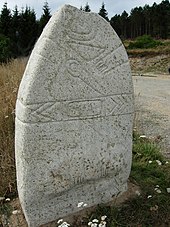Cambon-et-Salvergues
| Cambon-et-Salvergues | ||
|---|---|---|

|
|
|
| region | Occitania | |
| Department | Herault | |
| Arrondissement | Beziers | |
| Canton | Saint-Pons-de-Thomières | |
| Community association | Monts de Lacaune and Montagne du Haut Languedoc | |
| Coordinates | 43 ° 37 ′ N , 2 ° 52 ′ E | |
| height | 511-1,152 m | |
| surface | 50.39 km 2 | |
| Residents | 48 (January 1, 2017) | |
| Population density | 1 inhabitant / km 2 | |
| Post Code | 34330 | |
| INSEE code | 34046 | |
 Church Saint-Pierre |
||
Cambon-et-Salvergues is a municipality in the south of France with 48 inhabitants (as of January 1, 2017) in the Hérault department in the Occitanie region .
location
Cambon-et-Salvergues is located in the Haut-Languedoc Nature Park ( Parc naturel régional du Haut-Languedoc ) at an altitude of approx. 880 m above sea level. d. M. about 70 km (driving distance) northwest of Béziers near the border with the Tarn department ; the city of Montpellier is about 115 km to the east.
Population development
| year | 1872 | 1901 | 1926 | 1954 | 1975 | 1999 | 2009 | 2017 |
| Residents | 615 | 431 | 345 | 148 | 94 | 74 | 60 | 48 |
After it was founded in 1869, the community still had over 600 inhabitants. The phylloxera crisis in viticulture and the mechanization of agriculture then led to a steady decline in population to the current lows.
economy
For centuries the population lived on agriculture, which also included viticulture and cattle breeding, as a self-sufficient living . Since the middle of the 20th century, the rental of holiday apartments ( gîtes ) has been added as a source of income. A wind farm was built around the turn of the millennium .
history
The presence of humans in the region has been documented since prehistoric times, but there is no trace of the Celts , Romans and Visigoths . The sources are also silent for the Middle Ages, but the ruins of a Romanesque church are in the abandoned hamlet of Espinouse . Under the Ancien Régime until the French Revolution , the place belonged to the diocese of Saint-Pons-de-Thomières . The present-day community came into being in 1869 as a merger of several places from different communities in the surrounding area.
Attractions

- The most important cultural and historical testimony of the community is the statue menhir near the hamlet of Salverguettes from the 3rd or 2nd millennium BC. The stele-like stone, smoothed on all sides, shows a standing figure with a triangular breast pectoral and a dagger on its front . Your belly is surrounded by a wide belt made of braided leather strips (?). Two hanging stripes end in fringes; but both could also be interpreted as the legs and feet of the figure shown.
- The small Romanesque church of Espinouse was used for services until the first half of the 19th century. Today the apse as well as parts of the outer walls made of roughly hewn rubble stones and a vaulted side chapel still stand .
- The two churches of Cambon and Salvergues date from the 19th century.
Web links
- Cambon-et-Salvergues, Viticulture - Info (French)
- Salvergues Church - Photos + Info (French)
